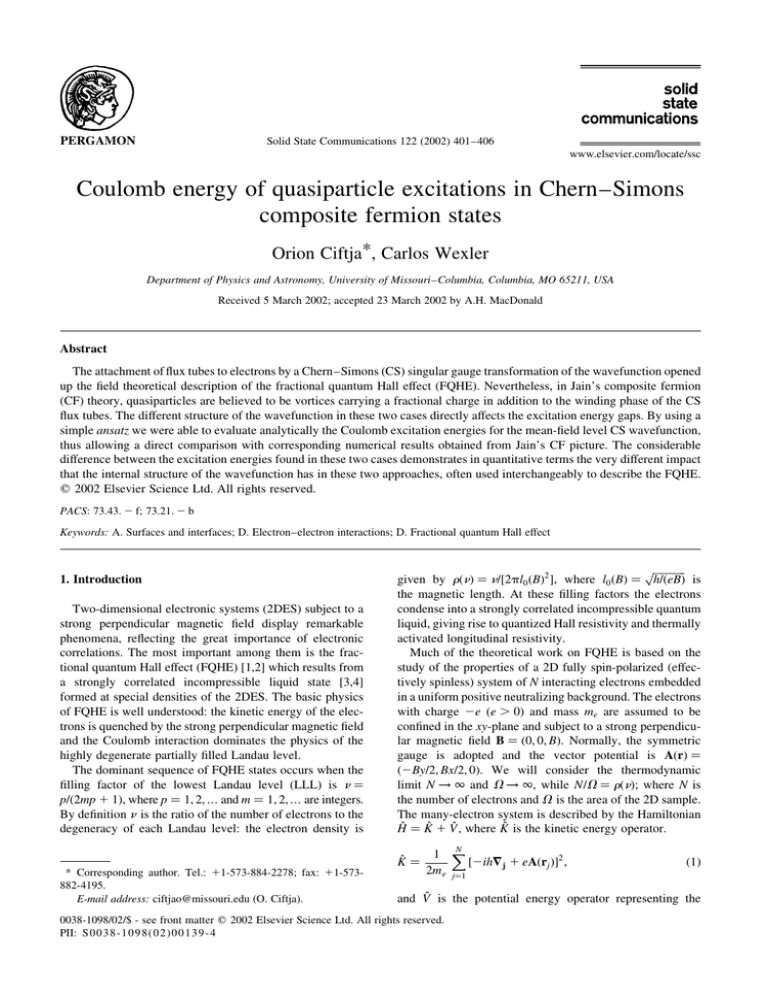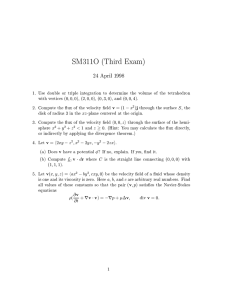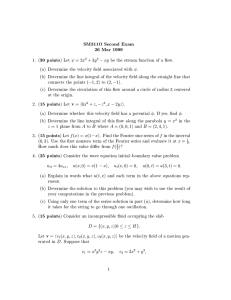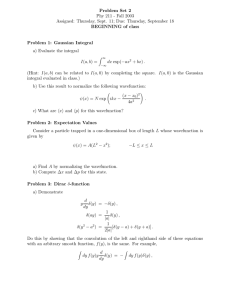Coulomb energy of quasiparticle excitations in Chern±Simons composite fermion states PERGAMON
advertisement

PERGAMON
Solid State Communications 122 (2002) 401±406
www.elsevier.com/locate/ssc
Coulomb energy of quasiparticle excitations in Chern±Simons
composite fermion states
Orion Ciftja*, Carlos Wexler
Department of Physics and Astronomy, University of Missouri±Columbia, Columbia, MO 65211, USA
Received 5 March 2002; accepted 23 March 2002 by A.H. MacDonald
Abstract
The attachment of ¯ux tubes to electrons by a Chern±Simons (CS) singular gauge transformation of the wavefunction opened
up the ®eld theoretical description of the fractional quantum Hall effect (FQHE). Nevertheless, in Jain's composite fermion
(CF) theory, quasiparticles are believed to be vortices carrying a fractional charge in addition to the winding phase of the CS
¯ux tubes. The different structure of the wavefunction in these two cases directly affects the excitation energy gaps. By using a
simple ansatz we were able to evaluate analytically the Coulomb excitation energies for the mean-®eld level CS wavefunction,
thus allowing a direct comparison with corresponding numerical results obtained from Jain's CF picture. The considerable
difference between the excitation energies found in these two cases demonstrates in quantitative terms the very different impact
that the internal structure of the wavefunction has in these two approaches, often used interchangeably to describe the FQHE.
q 2002 Elsevier Science Ltd. All rights reserved.
PACS: 73.43. 2 f; 73.21. 2 b
Keywords: A. Surfaces and interfaces; D. Electron±electron interactions; D. Fractional quantum Hall effect
1. Introduction
Two-dimensional electronic systems (2DES) subject to a
strong perpendicular magnetic ®eld display remarkable
phenomena, re¯ecting the great importance of electronic
correlations. The most important among them is the fractional quantum Hall effect (FQHE) [1,2] which results from
a strongly correlated incompressible liquid state [3,4]
formed at special densities of the 2DES. The basic physics
of FQHE is well understood: the kinetic energy of the electrons is quenched by the strong perpendicular magnetic ®eld
and the Coulomb interaction dominates the physics of the
highly degenerate partially ®lled Landau level.
The dominant sequence of FQHE states occurs when the
®lling factor of the lowest Landau level (LLL) is n
p=
2mp 1 1; where p 1; 2; ¼ and m 1; 2; ¼ are integers.
By de®nition n is the ratio of the number of electrons to the
degeneracy of each Landau level: the electron density is
* Corresponding author. Tel.: 11-573-884-2278; fax: 11-573882-4195.
E-mail address: ciftjao@missouri.edu (O. Ciftja).
p
given by r
n n=2pl0
B2 ; where l0
B h=
eB is
the magnetic length. At these ®lling factors the electrons
condense into a strongly correlated incompressible quantum
liquid, giving rise to quantized Hall resistivity and thermally
activated longitudinal resistivity.
Much of the theoretical work on FQHE is based on the
study of the properties of a 2D fully spin-polarized (effectively spinless) system of N interacting electrons embedded
in a uniform positive neutralizing background. The electrons
with charge 2e
e . 0 and mass me are assumed to be
con®ned in the xy-plane and subject to a strong perpendicular magnetic ®eld B
0; 0; B: Normally, the symmetric
gauge is adopted and the vector potential is A
r
2By=2; Bx=2; 0: We will consider the thermodynamic
limit N ! 1 and V ! 1; while N=V r
n; where N is
the number of electrons and V is the area of the 2D sample.
The many-electron system is described by the Hamiltonian
^ where K^ is the kinetic energy operator.
H^ K^ 1 V;
K^
N
1 X
2ih7 j 1 eA
rj 2 ;
2m e j1
1
and V^ is the potential energy operator representing the
0038-1098/02/$ - see front matter q 2002 Elsevier Science Ltd. All rights reserved.
PII: S 0038-109 8(02)00139-4
402
O. Ciftja, C. Wexler / Solid State Communications 122 (2002) 401±406
electron±electron, electron±background and background±
background interaction potentials
V^
N
X
j,k
1
v
urj 2 rk u 2 r
n
N Z
X
j1
d2 rv
urj 2 ru
r
n2 Z 2 Z 2
d r1 d r2 v
ur1 2 r2 u;
2
2
where v
urj 2 rk u
e2 =4pe0 euzj 2 zk u is the Coulomb
potential, zj xj 1 iyj is the location of the jth electron in
complex coordinates and e is medium's dielectric constant.
It has become clear in recent years that many features of
the FQHE can be understood in terms of a new kind of
particle called a composite fermion (CF), which is a
bound state of an electron and 2m vortices of the manybody quantum wavefunction [5,6]. The basic property of
the CFs is that they experience a reduced effective magnetic
®eld Bp B
1 2 2mn: Since the degeneracy of each
Landau level Ns is proportional to the magnetic ®eld, the
degeneracy Nsp of each CF Landau level will be Nsp
Ns
1 2 2mn: As a result, at ®lling factors corresponding
to the main sequence of FQHE states, n p=
2mp 1 1
(with p an integer), the effective ®lling factor of CFs will
be np p; that is, an integer number of CF LLs. In other
words, this transformation maps the FQHE of electrons onto
an integer QHE of CFs.
There are two calculational schemes based on the intuitive physics presented earlier. The ®rst constructs explicit
wavefunctions [5] while the second method employs a
Chern±Simons (CS) ®eld theory [7] approach to investigate
the CF state. Although the two schemes are based on the
same physics, a precise quantitative relationship between
them has not been made clear. In the CS approach proposed
by Halperin, Lee and Read [7] (HLR) to describe evendenominator-®lled states, the electron system is subjected
to a (mathematical) singular gauge transformation which
converts it into a new system of fermions interacting with
a CS magnetic-like ®eld b
r in addition to the original
magnetic ®eld. The transformation can be thought of as
the binding of 2m ®ctitious magnetic ¯ux quanta to an electron. If C n is a solution of the SchroÈdinger equation H^ C n
EC n it will be related by
Cn
N
Y
zj 2 zk 2m
j,k
uzj 2 zk u2m
C0;
3
to the wavefunction C 0 which is a solution of the SchroÈdinger
equation H^ 0 C 0 EC 0 ; with Hamiltonian H^ 0 K^ 0 1 V^ and
transformed kinetic energy operator,
K^ 0
N
1 X
{ 2 ih7 j 1 eA
rj 2 a
rj }2 ;
2m e j1
4
where a
r is the CS vector potential, b
r 7 £ a
r
2mf 0 r
rez is the ®ctitious CS magnetic ®eld, r
r is the
local particle density, f0 h=e is the magnetic ®eld ¯ux
quantum and ez is a unit vector perpendicular to the plane.
In a translationally invariant system, the mean-®eld
Hamiltonian may be obtained by replacing b
r by its
mean value kbl 2mf0 r
nez ; where r
n is the uniform
electronic density. This reduces the magnetic ®eld to Bp
B
1 2 2mn; thus increasing the effective ®lling factor np for
the CFs. When np r
nf0 =Bp p with p an integer, the
corresponding electron ®lling factor is n r
nf0 =B
p=
2mp 1 1; which is precisely the Jain's series of FQHE
states. In other words, at the mean-®eld level, the system can
be described as a system of fermions subject to a reduced
magnetic ®eld Bp B=
2mp 1 1: Therefore the CS ®eld
theory solution (at the mean-®eld level) will be the following CS CF wavefunction.
Cn
N
Y
zj 2 zk 2m
j,k
uzj 2 zk u2m
F p
Bp ;
5
where F p
Bp is the Slater determinant of p ®lled CF
Landau levels evaluated at the magnetic ®eld shown in the
argument.
Such singular gauge transformation of the wavefunction
corresponds to attaching 2m magnetic ¯ux tubes to each
electron. Flux tubes are neither charged, nor low-energy
excitations, so in reality it is not clear how electrons can
bind to them. In the CF theory, the quasiparticle is believed
to be an electron bound to 2m vortices, instead of 2m ¯ux
tubes. Differently from a ¯ux tube, a vortex brings a zero
into the wavefunction, is therefore charged and, as a result,
the attachment of vortices (instead of ¯ux tubes) brings a
signi®cantly different physics. In fact, attachment of
vortices forms the basis of the Jain's CF wavefunction
theory [5]. Under general circumstances, however, Jain's
CF wavefunction also needs a complete LLL projection in
order to generate results directly comparable with experiments. The LLL projection is quite far from being a trivial
operation and after projection it is not clear how to associate
electrons and vortices in an unambiguous way. Nevertheless, both projected and unprojected Jain's CF wavefunctions describe binding of vortices to electrons and a
signi®cant amount of work concerning both groundstate
and excited state properties of these wavefunctions has
been reported in the literature [8±11].
On the other hand, based on ®eld-theoretical grounds [12]
the attachment of ¯ux tubes, as in the CS CF wavefunction,
precedes the attachment of vortices. Although it is expected
that the attachment of ¯ux tubes to the wavefunction does
not capture the complete physics obtained by attachment of
vortices, a detailed quantitative comparison of the two
processes is highly desirable from a theoretical point of
view and has not yet been realized. Since the nature of
quasiparticles in the FQHE crucially depends on whether
¯ux tubes or vortices are attached to electrons, a study of
the low-energy excitations and excited state properties on
both cases seems to be quite appealing on its own.
O. Ciftja, C. Wexler / Solid State Communications 122 (2002) 401±406
Fig. 1. The characteristic integral C
p (Eq. (11)) plotted in a logarithmic scale as a function of p. The ®t corresponds to C
p /
p20:38 :
The intent of this work is to provide a comparison
between the excitation energies of ¯ux-bound CFs described
by the mean-®eld level CS CF wavefunction of Eq. (5) and
those obtained for wavefunctions where vortices instead of
¯uxes are attached. We provide analytical expressions for
the Coulomb excitation energy gaps corresponding to a
speci®c CS CF wavefunction that incorporates the idea of
¯ux binding to electrons and discuss the results in the
context of the HLR theory. We compare our analytic results
with corresponding numerical results obtained using Jain's
picture of CFs where vortices bind to electrons. We show in
quantitative terms how the excitation energy gaps are
affected by the internal structure of the wavefunction.
2. Coulomb excitation energies
The excitation energy gap is de®ned as the energy to add
one quasiparticle and one quasihole far away from each
other (we will neglect exciton effects) to the FQHE groundstate at the given ®lling factor. In the CF language, the
excitation energy gap corresponds to the quasiparticle±
quasihole excitation obtained by promoting a single CF
from the uppermost ®lled CF Landau level to the next higher
CF Landau level.
The excited state wavefunction constructed using CFs
(whether we have ¯ux tubes or vortices bound to electrons)
is not entirely in the LLL. Such intrinsic Landau level
mixing in the wavefunction brings in some kinetic energy
contribution into the excitation energy gap. In general, the
energy gap can be written as D
n Eg
n 1 DKE
n; where
Eg
n is due to Coulomb correlation effects and DKE
n
O
"vc is related to the kinetic energy associated with the
Landau level mixing. In the present work, we consider only
intra-LL excitations consistent with the (generally used)
assumption hvc ! 1: In this case only the Coulomb correlation energies are signi®cant and D
n ù Eg
n [9].
403
Exact calculations using Jain's CF approach have only
been possible in systems with a small number of electrons
[8]. However, for ¯ux-bound electrons as in the CS CF
picture, we point out that calculations can be readily
performed by adopting a technique ®rstly introduced by
Friedman and Pandharipande [13] in the context of nuclear
matter. Suppose we are studying the FQHE state with ®lling
n p=
2mp 1 1 having p CF Landau levels ®lled. The
uppermost ®lled CF Landau level is the one with quantum
index
p 2 1: The promotion of a CF from the CF Landau
level with quantum index
p 2 1 to the one with quantum
index p produces a correlated wavefunction C nph that
describes the quasiparticle±quasihole excitation. Instead
of promoting a single CF from the uppermost ®lled CF
Landau level to the next empty one, we choose to promote
a fraction DN xN
p Nsp of such CFs. By consequence
the quasiparticle±quasihole excitation energy will be given
by:
Eg
n lim
DN!1
2
DU
x; N;
2DN
6
where the change on the total correlation energy due to this
process is DU
x; N and x is the small fraction of displaced
CFs. Eq. (6) may be rewritten as
Eg
n lim
x!0
2 DU
x; N
;
2x
N
^ C nph
xl
^ Cnl
DU
x; N
1 kC nph
xuVu
1 kC n uVu
2
;
ph
ph
N
N kC n
xuC n
xl
N kC n uC n l
7
where C nph
x denotes the quasiparticle±quasihole wavefunction for xN quasiparticle±quasihole excitations (by
construction C nph
x 0 ; C n ). Only the ®rst term in Eq.
(7) is dependent on the fraction x; therefore one can write the
quasiparticle±quasihole excitation energy as
Eg
n lim
x!0
2
u
x;
2x n
8
where un
x is the correlation energy per particle corresponding to the quasiparticle±quasihole wavefunction,
un
x
^ C nph
xl
1 kC nph
xuVu
:
ph
N kC n
xuC nph
xl
9
The mathematical details of the calculation of un
x are
given in Appendix A (see Eq. (A10)). The ®nal result is
that the quasiparticle±quasihole Coulomb energy gap
corresponding to the CS CF wavefunction (Eq. (5)) is
given by:
Eg
n
e2
C
p
p ;
4pe0 el0
B 2mp 1 1
10
404
O. Ciftja, C. Wexler / Solid State Communications 122 (2002) 401±406
(is not projected) and has no special short-distance correlations when compared to Jain's CF wavefunction [5],
obtained by throwing away the denominators in Eq. (5)
and performing a projection onto the LLL [8,17]. In particular, the mean-®eld CS CF formalism does not lead to
screening of the quasiparticles' or quasiholes' charge, differently from the fractionalization of charge which occurs
beyond mean-®eld. Nevertheless both Jain's and the
mean-®eld CS wavefunctions describe at some level CFs,
and these have been generally assumed to be equivalent to a
®rst degree of approximation. The results presented in this
paper show how these assumptions can be misleading in
some circumstances.
3. Asymptotic behavior of the gap
Fig. 2. Exact excitation energy gaps, Eg
n corresponding to the
¯ux-bound CS CF wavefunction C n obtained at the mean-®eld
level of the CS ®eld theory for ®lling factors n p=
2mp 1 1 as
function of p for m 1 and 2 and p $ 1; see Eq. (10). The results
are compared to corresponding values for energy gaps [8] obtained
for the LLL projected Jain's CF wavefunction, where vortices
instead of ¯ux tubes are bound to electrons. All energies are in
units of e2 =4pe0 el0
B: For large p: Eg
n / p20:88 :
where the m-independent C
p is given by
!"
!
!#
Z1
2
t2
t2
t2
C
p
Lp21
2 Lp
dt e2t =2 L1p21
;
2
2
2
0
11
and Lan
x are associated Laguerre polynomials [14].
In what follows, we calculated exactly the integrals
appearing in Eq. (11) for increasing values of p up to
2000. The dependence of C
p on p is shown in Fig. 1. In
the large-p limit C
p / p20:38 :
In Fig. 2, we show the dependence of Eg
n on p for ®lling
factors n p=
2mp 1 1 for m 1 and 2 with the excitation
energy values expressed in units of e2 =4pe0 el0
B: A striking feature of the results is the fact that the excitation energy
gaps decrease very slowly as we approach the evendenominator-®lled states n 1=2
m 1 and n 1=4
m
2 where, as expected, they vanish. To give a quantitative
estimate of how the energy excitation gap is affected when
we switch from ¯ux attachment to vortex attachment, we
compare our analytic results for ¯ux-bound CFs to Monte
Carlo results [8,15,16,] based on Jain's CF wavefunctions
where vortex attachment is considered. One notes that the
energy gaps for ¯ux-bound CFs are considerably above the
energy gaps obtained in the vortex-bound case. Our analytic
results for ¯ux-bound CFs are based on a mean-®eld wavefunction, so we have to expect an overestimation of the
energy gaps since we are neglecting ¯uctuations, however,
the large difference was not completely anticipated.
The wavefunction C n obtained at the mean-®eld level of
the CS theory (Eq. (5)) has a high occupation of higher LLs
As the ®lling factor of the main sequence of FQHE states
approaches the even denominator fractions 1/2 and 1/4
(obtained as p ! 1 and m 1 and 2, respectively) it is
expected that the quasiparticle±quasihole excitation gap
should vanish. From the behavior of C
p shown in Fig. 1
and Eq. (10), it is evident that this is, indeed, the case: our
analysis of the exact CS excitation energies shows that Eg
n
decays as p20:88 to a very good approximation for 50 & p &
2000:
These results can be compared to the HLR theory at both
mean-®eld [7] and beyond [18]. At the mean-®eld level, the
HLR theory [7] predicts
p
1
1
e2
Eg n
,
;
12
2mp 1 1
2mp 1 1 4pe0 el0
B
as p ! 1: This behavior is consistent with the fact that
within this mean-®eld theory the effective mass mp is
unrenormalized by the ¯uctuations of the CS gauge ®eld
(see Eq. (4)) and should be p-independent. Since our
approach neglects all ¯uctuation effects, the resulting
large p energy gaps should decay at most as fast as 1=p:
Our results are consistent with this argument.
When interactions beyond the mean-®eld and/or RPA
level are included and ¯uctuations in the transverse CS
gauge ®eld are considered, a considerable renormalization
of the effective mass is to be expected. In fact, using a
fermionic CS approach, Stern and Halperin [18] considered
these ¯uctuations and found a divergent renormalization of
mp as p ! 1: Therefore in this limit, the low energy excitations vanish faster as
Eg <
p
1
1
e2
p
:
2m m
2mp 1 1ln
2mp 1 1 4pe0 el0
B
13
At present time, a fully exact calculation of energy gaps,
starting from a microscopic wavefunction that incorporates
effects beyond mean-®eld theory appears to be a very dif®cult task.
Quite recently, a sophisticated calculation for the FQHE
energy gaps has been performed by Shankar [19] using the
O. Ciftja, C. Wexler / Solid State Communications 122 (2002) 401±406
Hamiltonian theory of CFs that he and Murthy developed
[20]. In their Hamiltonian approach one ®rstly performs a
2m-fold ¯ux attachment by a CS transformation, and then
attaches the necessary number of zeros to transform the
¯uxes into full vortices [20]. In this approach, the Hamiltonian contains complicated expressions for the charge and
other operators, while the wavefunction remains quite
simple (this treatment seems complimentary to Jain's
approach, where the Hamiltonian is simple, but the wavefunction is very complicated because of the LLL projection
operator). The formalism was then used to compute activation gaps for FQHE states and analytic expressions were
derived for all fractions of the form n p=
2mp 1 1:
Based on this approach various quantities of interest were
calculated to a reasonable accuracy: in particular it was
shown that for the Zhang±Das
Sarma
[21] (ZDS) interaction
p
potential, v
r e2 =
e r 2 1 l2 ; the gap energies were
accurate to within 10±20% as compared to Monte Carlo
work [22] for l . 1: Favorable electronic correlations in
the LLL are build up only through vortex attachment, as a
result the energy gaps derived from the Hamiltonian theory
are in better agreement and directly comparable to experimental and/or Monte Carlo results.
On the other hand, we limited ourselves to a mean-®eld
model with a speci®c choice of the wavefunction incorporating attachment of 2m-fold ¯ux tubes to electrons. We were
thus able to provide analytical results strictly valid for the
speci®c choice of the mean-®eld derived CS CF wavefunction, without intending to directly compare the obtained
energy gap values to realistic calculations where 2m-fold
vortices are attached to the electrons and full projection
into the LLL is performed. The objective of this calculation
was to demonstrate the signi®cant effect that the lack of
vortex attachment has on the excitation properties of the
system. This is important due to the generalized impression
that most of the physics of the FQHE is contained in the
simple CS mean-®eld model.
4. Conclusions
In summary, by using a simple ansatz we were able to
calculate analytically the excitation energy gaps for a mean®eld CS CF wavefunction where 2m-fold ¯ux tubes are
attached to electrons. This provides a direct quantitative
comparison with corresponding numerical results for energy
gaps where vortices, and not ¯ux tubes, are bound to electrons as in Jain's CF wavefunction case. Based on these
analytical results, we can directly estimate in quantitative
terms the sizeable effect that the internal structure of CFs
has on FQHE energy gaps, when switching from ¯ux attachment to vortex attachment. The large discrepancy in the
excitation energies thus obtained clearly shows the limitations of the commonly held belief that most of the important
physics of the FQHE is contained in the simple mean-®eld
approximation of the CS CF picture.
405
Acknowledgements
This work was supported in part by the University of
Missouri Research Board and Research Council (CW).
Appendix A
For convenience we list here the calculation of the
Coulomb correlation energy per electron un
x (Eq. (9))
which is given by
un
x
^ C nph
xl
1 kC nph
xuVu
ph
N kC n
xuC nph
xl
r
n Z 2
d r12 gn
x; r12 2 1v
r12 ;
2
A1
where the radial distribution function gn
x; r12 is de®ned in
terms of C nph
x by
gn
x; r12
R
N
N 2 1 d2 r3 ¼d2 rN uC nph
xu2
:
R 2
r
n2
d r1 ¼d2 rN uC nph
xu2
A2
In the thermodynamic limit, the above quantity depends on
the 2D interparticle distance r12 ur1 2 r2 u and the quasiparticle±quasihole fraction parameter x. In our case, one
observes that uC nph
xu2 uF p
x; Bp u2 ; where the latter
term corresponds to a squared Slater determinant representing
p 2 1 fully ®lled CF Landau levels, the pth CF Landau
level (with CF Landau level index
p 2 1) ®lled except for
DN xN
p Nsp CF holes, and the
p 1 1th CF Landau
level (with CF Landau level index p) having the DN CFs
that were removed from the underlying level. As a standard
result, it follows that for fully spin-polarized electrons (CFs)
gn
x; r12 1 2 ulp
x; r12 u2 ;
A3
where the `statistical exchange' factor is computed from
lp
x; r12 r^ p
x; r1 ; r2 =r
n: The (reduced) one-body
density matrix r^ p
x; r1 ; r2 which corresponds to the dynamically uncorrelated state F p
x; Bp is given by
r^ p
x; z1 ; z2
p
pX
2 1 NX
s 21
n0
1
2
l0
DN
Nsp
Nsp
" Np 2 1
s
X
21
X
l0
wpn;l
z1 ´wn;l
z2
l0
wpp;l
z1 ´wp;l
z2
#
wp
p21;l
z1 ´w
p21;l
z2 ;
A4
where DN=Nsp xp is the average occupancy of a quantum
state in the partially ®lled CF Landau level with index p. The
symmetric gauge single-particle eigenstates for magnetic
406
O. Ciftja, C. Wexler / Solid State Communications 122 (2002) 401±406
p
®eld B are
"
#
1
zzp
exp
wn;l
z p
n
4l0
Bp 2
2 n!
"
#)
n (
zzp
p 2
;
A5
w0;l
zexp 2
2l0
B
2z
4l0
Bp 2
where
"
l
p
where n 0; 1; ¼ denotes the index of various CF Landau
levels and l 0; 1; ¼
Nsp 2 1 is their angular momentum
quantum number. Noting that
! Np 2 1
p
NX
2
s 21
s
X
r12
p
´
wn;l
z1 wn;l
z2 Ln
wp0;l
z1 w0;l
z2 ;
p 2
2l
B
0
l0
l0
A7
r^ p
x; z1 ; z2
(
p
NX
s 21
l0
wp0;l
z1 w0;l
z2
"
2
r12
2l0
Bp 2
1 xp Lp
L1p21
2
r12
2l0
Bp 2
!
2 Lp21
!
2
r12
2l0
Bp 2
!#)
;
A8
x
n
n
n 2x
where Ln
x
e =n!
d =dx
x e are the Laguerre polynomials of order n 0; 1; ¼ and Lkn
x
21k
dk =dxk Ln1k
x are the generalized Laguerre polynomials of
order n 0; 1; ¼ and degree k 0; 1; ¼
In the thermodynamic limit [23], both density and ®lling
factor n N=Ns are kept constant as the number of electrons
N and the Landau level degeneracy Ns go to in®nity. Since
the degeneracy Nsp of each CF Landau level is directly
proportional to Ns then also
Nsp 2 1 goes to in®nity in
this limit. At this point the summation over l in Eq. (A8)
is extended from 0 to 1 and one obtains the one-body
density matrix r^ p
x; z1 ; z2 that no longer depends on Nsp :
The statistical exchange term lp
x; z1 ; z2 r^
x; z1 ; z2 =r
n
is a complex quantity, but since the radial distribution function is found by squaring it (see Eq. (A3)), the phase factor
of lp
x; z1 ; z2 vanishes and we obtain
"
#(
!
2
2
r12
1 1
r12
gn
x; r12 1 2 exp 2
L
p p21 2l0
Bp 2
2l0
Bp 2
"
1 x Lp
2
r12
2l0
Bp 2
!
2 Lp21
2
r12
2l0
Bp 2
Z1
p
t2
un
x 2 p
dt exp 2
2
2 2mp 1 1 0
"
#
1
z
zz
w0;l
z p
;
A6
p exp 2
p 2
l
p
2
l
B
4l
2 l!2pl0
B
0
0
B
one ®nds that
The calculation of un
x follows from Eq. (A1). After writing r
n p=2pl0
Bp 2 ; we introduce the dimensionless
variable t r12 =l0
Bp ; and by rescaling the magnetic length
l0
Bp 2 l0
B2
2mp 1 1 we obtain
!#)2
:
A9
1 x Lp
t2
2
!
2 Lp21
t2
2
!#)2
!(
1 1
t2
Lp21
2
p
!
1
e2
:
4pe0 el0
B
A10
The results in Eqs. (10) and (11) follow immediately.
References
[1] R.E. Prange, S.M. Girvin (Eds.), The Quantum Hall Effect
Springer, New York, 1990.
[2] T. Chakraborty, P. PietilaÈinen, The Fractional Quantum Hall
Effect, Springer, New York, 1988.
[3] D.C. Tsui, H.L. Stormer, A.C. Gossard, Phys. Rev. Lett. 48
(1982) 1559.
[4] R.B. Laughlin, Phys. Rev. Lett. 50 (1983) 1395.
[5] J.K. Jain, Phys. Rev. Lett. 63 (1989) 199.
[6] J.K. Jain, Phys. Rev. B 41 (1990) 7653.
[7] B.I. Halperin, P.A. Lee, N. Read, Phys. Rev. B 47 (1993)
7312.
[8] J.K. Jain, R.K. Kamilla, Phys. Rev. B 55 (1997) R4895.
[9] N.E. Bonesteel, Phys. Rev. B 51 (1995) 9917.
[10] R.K. Kamilla, J.K. Jain, S.M. Girvin, Phys. Rev. B 56 (1997)
12411.
[11] K. Park, J.K. Jain, Phys. Rev. Lett. 81 (1998) 4200.
[12] A. Lopez, E. Fradkin, Phys. Rev. B 44 (1991) 5246.
[13] B. Friedman, V.R. Pandharipande, Phys. Lett. 100B (1981) 3.
[14] I.S. Gradshteyn, I.M. Ryzhik, in: A. Jeffrey (Ed.), Table of
Integrals, Series, and Products, ®fth Ed, Academic Press, New
York, 1980, pp. 1064±1065.
[15] J.K. Jain, R.K. Kamilla, in: O. Heinonen (Ed.), Composite
Fermions, World Scienti®c, New Jersey, 1998.
[16] J.K. Jain, R.K. Kamilla, Int. J. Mod. Phys. B 11 (1997) 2621.
[17] R.K. Kamilla, J.K. Jain, Phys. Rev. B 55 (1997) 9824.
[18] A. Stern, B.I. Halperin, Phys. Rev. B 52 (1995) 5890.
[19] R. Shankar, Phys. Rev. B 63 (2001) 085322 and references
therein.
[20] R. Shankar, G. Murthy, Phys. Rev. Lett. 79 (1997) 4437.
[21] F.C. Zhang, S. Das Sarma, Phys. Rev. B 33 (1986) 2908.
[22] K. Park, N. Meskini, J.K. Jain, J. Phys.: Condens. Matter 11
(1999) 7283.
[23] O. Ciftja, Phys. Rev. B 59 (1999) 8132.






